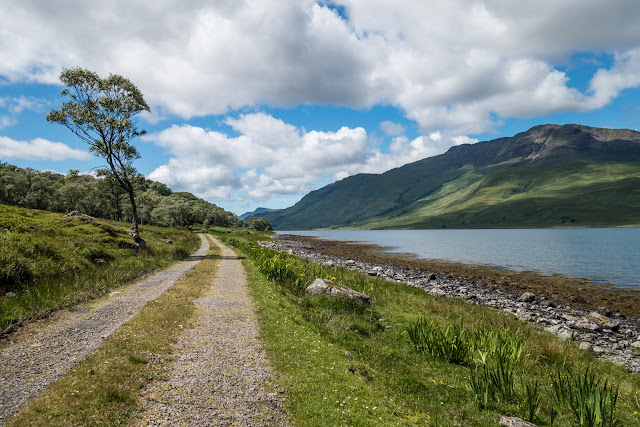Loch Spelve and otters
Located in the south-eastern ‘corner’ of Mull, Loch Spelve is a large tidal body of water bounded by an unclassified single track road which branches off at its western end with one track running back along the southern shores of the loch to Croggan and the main track running west to Loch Buie. Being just south of where we were staying, it looked a great place to explore.
Definitely an `unclassified single track road`!
We had read of the otters being seen here. On arriving to park, we were cruising along the Loch side when we spotted a woman, loaded with camera gear coming toward us. On speaking to her, it transpired that she and her husband (both keen photographers), were in the area photographing otters. Soon afterwards she caught our attention and we followed her along the loch as an otter went about his business on the loch side. Magic!
Another view of the lock and an interesting tree by the side
Curlew on Loch Spelve shore
Oystercatcher by the loch
Was this an old highlanders house destroyed in the Highland clearances?
To quote an article in the SCOTSMAN:
THE HIGHLAND Clearances are an infamous chapter in Scottish history, the cruel story of how the Highland people were dispossessed of their homes by their landlords. So emotive is the subject that many writers denounce the clearances as the first act of modern ethnic cleansing. Yet, while economic forces did change the face of the Highlands forever, the clearances were not a single act of genocidal intent. The clearances largely took place between the 1770s and 1850s, although eviction struggles continued until the end of the 19th century, such as the Battle of the Braes in 1882. The end of the Highland way of life really began with the Jacobite defeat at Culloden in 1746, when the British government swiftly acted to break the resistance of the proudly independent Gaelic society. Highlanders could no longer meet in public or bear arms. The wearing of tartan, teaching Gaelic and even playing the bagpipes were outlawed by the 1747 Act of Proscription. The act was repealed in 1782, but by then a more grave set of threats to the old clan system had emerged: economic collapse and agricultural revolution. The Highland economy was based largely on subsistence farming and the export of cattle, as well as kelp from the coast used to make glass and soap. At the time, many landlords complained not that there were too many Highlanders but that too many were leaving, forcing the government to pass the 1803 Ships’ Passengers Act that tightened emigration laws. This situation changed radically as the cattle and kelp industries collapsed following peace with France in 1815. At the same time, the agricultural revolution began changing the shape of farming throughout Europe from small- to large-scale production. The early Highland Clearances occurred alongside the second round of enclosures in England, where small holders were forced to leave common lands. Further, the agricultural economy shifted as demand grew for sheep in the newly industrialising cities. Sheep became more desirable to some landlords than their Highland tenants. The most notorious of the Highland Clearances occurred on the estates of the Countess of Sutherland between 1811 and 1821. Riots in Sutherland in 1813 failed to dissuade the Countess from her desire to replace Highlanders with sheep. Many families were burned out of their home. A local, Donald MacLeod, reported that from a hill he saw 250 homes from one district ablaze. The fires lasted six days. In 1816, the Countess’s factor, Patrick Sellar, was acquitted by a court on charges of arson and culpable homicide.
White Heath spotted orchid
Fritillary butterfly
Victoria Jubilee This pyramid shaped monument is also on the right hand side of the road alongside Loch Uisg – shortly after the Red Monument – and just before the end of the Loch. It is set beside the road, but is some 3 meters above the road level on a low bluff of rock. The plaque reads; “Erected by Lochbuie and his Highlanders to commemorate Queen Victoria’s Diamond Jubilee, 22 June 1897. God Save the Queen”
Lochbuie Post office - unmanned, with its honesty box in the image above. Not sure how that would work in many places!
To round off a very pleasant day, this was the view from our kitchen window in the evening.
















Comments